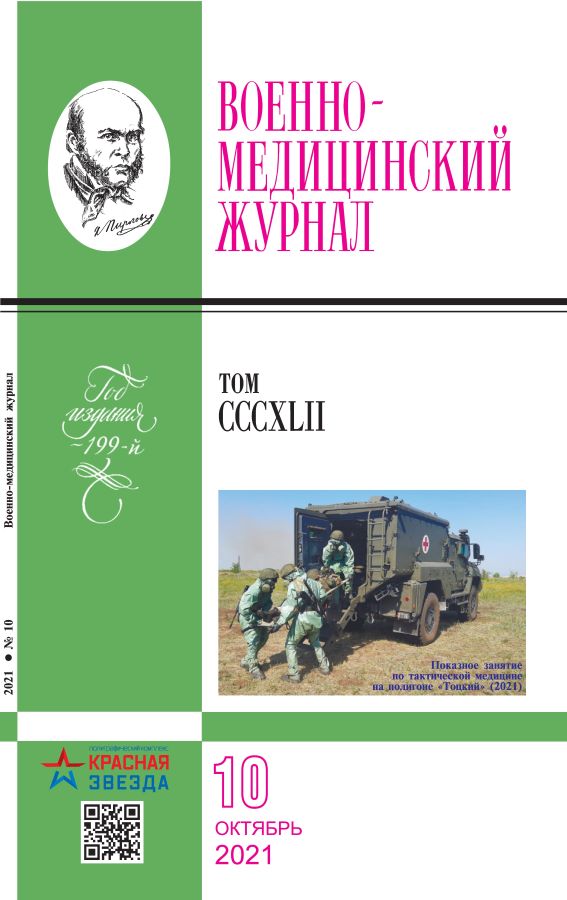Features of the treatment of full-thickness rotator cuff tendon rupture in military personnel
- 期: 卷 342, 编号 10 (2021)
- 页面: 25-31
- 栏目: Treatment and prophylactic issues
- URL: https://journals.eco-vector.com/0026-9050/article/view/627384
- DOI: https://doi.org/10.52424/00269050_2021_342_10_25
- ID: 627384
如何引用文章
详细
The mid-term clinical, functional, and structural results of surgical treatment of servicemen with a full-thickness rupture of the rotator cuff of the shoulder joint were evaluated in 2 groups: in the 1st (n=30), treatment was performed using the single-row suture technique, in the 2nd (n=30) – according to the technique double-row seam with or without the installation of a balloon spacer. The functional results were assessed using the ASES and UCLA scales, and the structural integrity of the reconstructed tendon was assessed on postoperative MRI in 5 categories. The postoperative assessment was performed 12–16 months after surgery. The average UCLA score increased significantly from 17.9 to 31.2 in the 1st group and from 18.3 to 32.3 in the 2nd, according to the ASES scale – from 44.9 to 89.2 in the 1st group. 1st and from 42.5 to 92.1 in the 2nd. Assessment of postoperative MRI by H.Sugaya types revealed type I in 6 patients (20%) in group 1, type II – in 5 (16.7%), III – in 10 (33.3%), IV– in 4 patients (13.3%), V – in 5 patients (16.7%), in the 2nd group – type I – in 11 (36.7%), II – in 8 (26.7%), III – in 8 (26.7%), IV – in 3 (10%), V– was not found. Comparison of the mid-term clinical and functional results did not reveal significant differences between the single-row and double-row suture techniques. Comparison of the structural integrity of the reconstructed tendon showed the undeniable advantages of the double-row suture technique.
参考
- Доколин С.Ю., Кузьмина В.И., Марченко И.В., Белых О.А., Найда Д.А. Артроскопический шов больших и массивных разрывов вращательной манжеты плечевого сустава: клинические результаты и данные МРТ // Травматол. и ортопед. России. – 2017. – Т. 23, № 3. – С. 53–68.
- Лазко М.Ф., Призов А.П., Лазко Ф.Л. и др. Опыт применения субакромиального баллона в лечении пациентов с большими, массивными невосстанавливаемыми повреждениями вращательной манжеты плеча // Клин. практика. – 2020. – № 4 (11). – С. 14–22.
- Chen M., Xu W., Dong Q. et al. Outcomes of single-row versus double-row arthroscopic rotator cuff repair: a systematic review and meta-analysis of current evidence // Arthroscopy: The J. of Arthroscopic & Related Surgery. – 2013. – N 8 (29). – P. 1437–1449.
- Chevalier Y., Pietschmann M., Thorwаchter C. et al. Biodegradable spacer reduces the subacromial pressure: a biomechanical cadaver study // Clin. Biomechanics. – 2018. – Vol. 52. – P. 41–48.
- D’Ambrosi R., Palumbo F., Paronzini A. et al. Platelet-rich plasma supplementation in arthroscopic repair of full-thickness rotator cuff tears: a randomized clinical trial // Musculoskeletal surg. – 2016. – N 1 (100). – P. 25–32.
- Goutallier D., Postel J. M., Bernageau J. et al. Fatty muscle degeneration in cuff ruptures. Pre-and postoperative evaluation by CT scan // Clin. orthopaedics and related research. – 1994. – N 304. – P. 78–83.
- Hamada K., Fukuda H., Mikasa M., Kobayashi Y. Roentgenographic findings in massive rotator cuff tears. A long-term observation // Clin. orthopaedics and related research. – 1990. – N 254. – P. 92–96.
- Longo U.G., Ambrogioni L. R., Candela V. et al. Conservative versus surgical management for patients with rotator cuff tears: a systematic review and META-analysis // BMC musculoskeletal disorders. – 2021. – N 1 (22). – P. 50.
- Mascarenhas R., Chalmers P N., Sayegh E.T. et al. Is double-row rotator cuff repair clinically superior to single-row rotator cuff repair: a systematic review of overlapping meta-analyses // Arthroscopy: The J. of Arthroscopic & Related Surg. – 2014. – N 9 (30). – P. 1156–1165.
- Millett P.J., Warth R.J., Dornan G.J. et al. Clinical and structural outcomes after arthroscopic single-row versus double-row rotator cuff repair: a systematic review and meta-analysis of level I randomized clinical trials // J. of Shoulder and Elbow Surg. – 2014. – N 4 (23). – P. 586–597.
- Snyder S.J. Southern California Orthopaedic Institute rotator cuff classification system / Shoulder arthroscopy. Lippincott Williams and Wilkins. – Philadelphia, 2003. – P. 203–207.
- Sugaya H., Maeda K., Matsuki K., Moriishi J. Repair integrity and functional outcome after arthroscopic double-row rotator cuff repair. A prospective outcome study // J. of bone and joint surg. Amer. volume. – 2007. – N 5 (89). – P. 953–960.
- Takayama K., Yamada S., Kobori Y. Clinical outcomes and temporal changes in the range of motion following superior capsular reconstruction for irreparable rotator cuff tears: Comparison based on the Hamada classification, with or without shoulder pseudoparalysis, and status of the subscapularis tendon // J. of Shoulder and Elbow Surg. – 2021. – N 2 (17). – P. 67–74.
- Wang C., Xu M., Guo W. et al. Clinical efficacy and safety of platelet-rich plasma in arthroscopic full-thickness rotator cuff repair: A meta-analysis // PloS one. – 2019. – N 7 (14). – P. e0220392.
补充文件






